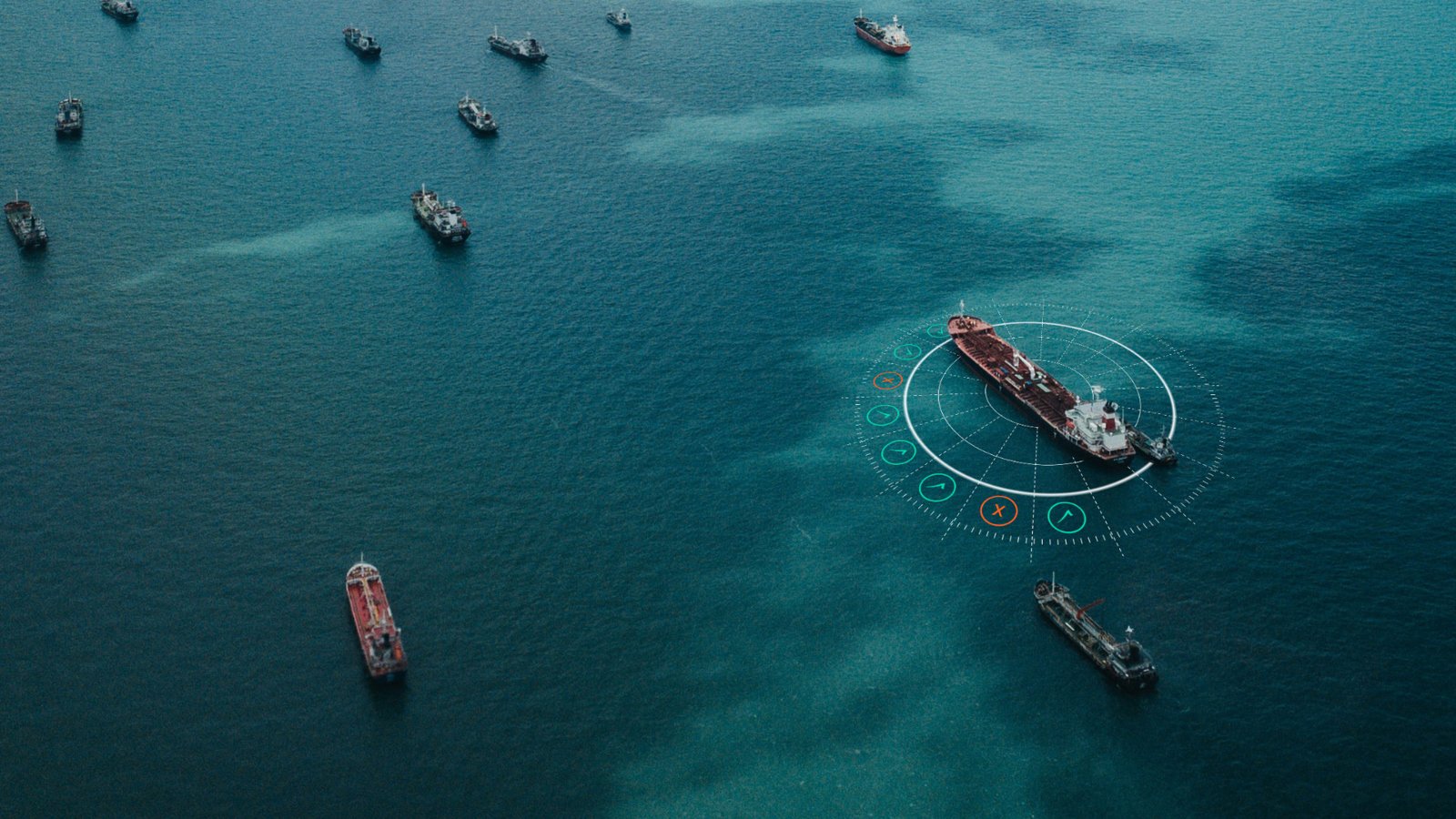
Container vessels of the future
Kongsberg Maritime’s integrated systems have been designed to help vessel owners prepare for the fuels and demands of tomorrow
-
Text:Marketing & Communication Department
Photo:© Kongsberg Maritime
-
Craig TaylorSenior Manager PR & Communications
Kongsberg Maritime’s container ship solutions have been developed with two core aims: to deliver efficiencies and sustainability benefits for today’s markets, and to prepare the industry for future developments.
Strategies to meet the first aim, though challenging, gain from being based on a known set of parameters, such as available technologies and fuel infrastructure. Based on these, Kongsberg Maritime has been able to propose systems which can have an immediate benefit to vessel owners. A core component of these proposals is the widespread adoption of dual-fuel engines and LNG: although a fossil fuel, LNG’s green credentials make for conclusive reading when viewed against MGO. CO2 emissions are reduced by 24%, NOX emissions by 87% and SOX emissions by a whopping 99%. Particulate matter is negligible, and our analysis demonstrates that the benefits are not only environmental – operators can expect OPEX savings of up to 20%.
Installing Power Take Off technology
Adoption of Power Take Off (PTO) technology is another key strategy. Propulsion engines often run significantly below maximum load, so by installing a PTO this spare capacity can be converted into useful extra power at little extra cost. This approach has several advantages, triggered by reducing the number of auxiliary generator sets required. These generator sets are usually four-stroke, discharging more harmful greenhouse gas (GHG) emissions through methane slip than two-stroke propulsion engines; running fewer engines consequently reduces fuel use, emissions, engine wear and service overheads; and the auxiliary generator sets still deployed can be worked harder, closer to their peak efficiency at around 85% loading.
But how can these technologies protect ship owners from future developments, ensuring that modifications to embrace new fuels and meet new regulations can be made at a cost which is consistent with continuing business needs and profitability?

Prospective fuel sources
There’s no doubt that one of the foremost questions in vessel owners’ minds when specifying a newbuild or refit is how they will manage the introduction of new fuels – the so-called ‘fuel transition’. Several alternatives are waiting in the wings – HVO (Hydrotreated Vegetable Oil), synthetic methane, methanol, liquefied hydrogen (LH2), ammonia (NH3) and liquid biogas (LBG) to name but a few – and the problem is that no-one knows which will be adopted.
With no conclusive answers, the logical solution is to equip vessels with engines and systems which will allow as many of these fuels to be used as possible, with zero or minimal modifications. That’s Kongsberg Maritime’s approach, delivered via its integrated LNG Fuel Gas Supply System (FGSS). This system comprises the LNG storage tank, LNG Process System, Bunker Station and Control & Safety System, and is a key component in KM’s LNG solution and advocacy of LNG as a fuel.

“If we design the LNG system in the right way, conversion to operation on ammonia is relatively simple. NH3 is very corrosive, so the tanks and fuel transport components need to be able to handle that. Also, it is less space efficient, requiring more tank volume for the same energy output compared with LNG, so vessels need to be designed in a way that allows more tanks to be added easily. Our container feeder vessel is a good example of how this can be achieved – the open-top design allows tanks to be added below the containers, without compromising cargo capacity.”Oskar Levander, SVP Business Concepts, Kongsberg Maritime.
LNG: a practical fuel choice for today
The global LNG infrastructure is growing rapidly, making it a practical choice of fuel for today – especially for vessels equipped with dual-fuel engines, which can fall back on MGO as necessary – but LNG has an additional advantage in that it is chemically close to several of the proposed new fuels. “Installing an LNG system gives you choices,” explains Oskar Levander, SVP Business Concepts, Kongsberg Maritime. “Synthetic methane and LBG are methane fuels, just like LNG. That means an LNG-powered vessel is ready for at least two new low-carbon or carbon-neutral fuels with no modification at all. A dual-fuel engine that can burn MGO, meanwhile, can also switch to renewable HVO with little or no upgrade required.”
Ammonia is also only a short step away. “If we design the LNG system in the right way, conversion to operation on ammonia is relatively simple,” continues Levander. “NH3 is very corrosive, so the tanks and fuel transport components need to be able to handle that. Also, it is less space efficient, requiring more tank volume for the same energy output compared with LNG, so vessels need to be designed in a way that allows more tanks to be added easily. Our container feeder vessel is a good example of how this can be achieved – the open-top design allows tanks to be added below the containers, without compromising cargo capacity.” NH3-based systems will also require exhaust aftertreatment for NxO slip.
KM is also researching the use of hydrogen, in both liquid and gas phases. Inevitably, its flammability and explosive nature make safety a key concern, so extensive work is required before it is approved for use. As part of the EU-funded HySeas III project, a KONGSBERG facility in Ågotnes, Norway is currently carrying out the first long-term, full-scale and full-size testing of a zero-emissions drivetrain powered by hydrogen fuel cells, prior to proposed testing on a prototype road ferry in Orkney, UK. There is some doubt, however, as to how applicable this technology will be to container ships in the future: the expense of storage and the amount of space required are likely to restrict use of LH2 to locally operated vessels traversing shorter routes.
Going electric
With electric and plug-in hybrid cars becoming increasingly common, it’s a fair question to ask if the same technology can be applied to ships. The answer, of course, is yes – projects such as the autonomous cargo carriers currently being built for the Norwegian grocery chain ASKO are using fully electric propulsion from batteries, and Kongsberg Maritime offers a charging system suitable for plug-in hybrid applications with its SAVe Charge solution.
The challenges are twofold. The first is infrastructure – very few ports offer power connections with the kind of capacity that would be needed for charging propulsion system batteries. The second is more far-reaching. Can using shore-supplied power be guaranteed to be more sustainable than generating electricity from fuel on board?

Powering ASKO vessels in the Oslo-fjord
For projects such as the ASKO vessels, these questions are easy to answer. The ships will shuttle back and forth across the Oslofjord, between fixed facilities which will be equipped with the necessary charging infrastructure as part of the project. Power will come from Norway’s national grid, which currently derives 98% of its power from renewable sources: mostly hydro power.
Vessels making longer voyages between multiple ports have more problems to solve. Full battery operation for ocean passages is currently impracticable owing to the size and cost of energy storage, but there is the potential to use hybrid systems with stored energy to allow zero-emission operation on pure batteries in local areas, for example entry to and exit from port.
But even if charging infrastructure improves, the provenance of the power must be assured – something Kongsberg Maritime calls a ‘well to wake’ approach. “A great deal depends on how dirty the electricity is on land,” explains Levander. “From a CO2 emissions perspective, if we charge from shore, we need to ensure that the vessel’s shore connection has clean energy going to it, and details such as these are part and parcel of our integrated solutions for instilling lean and green operational efficiencies.”
If multiple energy sources are to be used on board, they will need to be managed, and our hybrid propulsion technologies can be integrated within its Energy Management 2.0 system, which harvests sensor data from sources including the propulsion and automation systems, the engines and the deck machinery. The system processes this data in real time, and the resulting information on fuel consumption and the vessel’s energy efficiency reinforces the informed decision-making necessary to further cut down on fuel usage. This data is automatically logged, so performance indicators can be benchmarked against historical values. This provides crews with an extra dividend as it constitutes a digital record which can be verified and extracted to prove a vessel’s regulatory compliance.
New fuels future-proof vessels
Flexibility, integration and digitalisation are vital to providing future-proof solutions for container vessels. By allowing easy adoption of a range of potential new fuels, seamless integration of hybrid solutions and full control and monitoring of all onboard systems, vessel owners can be assured that they are as prepared as possible today for the container industry of tomorrow